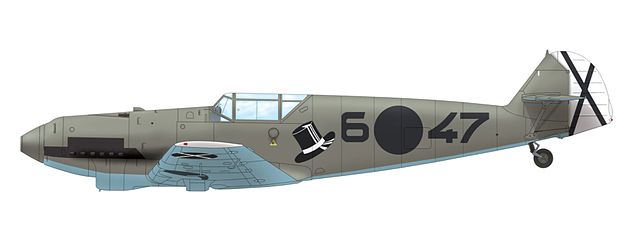Kept under a veil of civilian airlines, glider clubs, and civil aviation clubs, the Luftwaffe emerged as a military force while the rest of Europe slept, and the He 51 was the backbone fighter of the newly established German Air Force.
Difficult and Deceitful Times
With the end of World War One in 1918 and the signing of the Treaty of Versailles in 1919, Germany found itself in both an economic and military downspin. Germany was forced by 1920 to surrender all of its aeronautical assets. Over 15,000 aircraft were surrendered under allied supervision, and development and production of military aircraft was strictly prohibited.
However, the restrictions on civil aircraft were much more lenient, this sector being largely overlooked because civil aviation was in its infancy. There were some restrictions placed in 1922 on the size of civil aircraft, but in 1926 the Paris Air Agreement removed most of those.
Using the guise of civil aviation, the Germans exploited this loophole, and began once again designing, building, and testing aircraft, most of them with hidden military purposes, unhindered. The very foundations of a secret new air force were being laid down. When a six month standstill expired after the signing of the Treaty of Versailles, the aircraft manufactures began to produce once again.
Heinkel
One of those companies, Heinkel Flugzeugwerke, formed in 1922 by Ernst Heinkel at Warnemünde, had been producing aircraft mostly for foreign customers in rather small numbers through the 1920’s. The Soviet Union was a major customer, purchasing fighter biplanes and floatplanes, and eventually license-built several in the early 1930’s. Heinkel was designing and building single seat metal and fabric covered biplane fighters, and one designated the He 49A first flew in November, 1932.
The He 49A had a clean, low drag fuselage, but showed directional instability leading to the addition of a section in the fuselage of over 15 inches in length. This aircraft was designated the He 49B and flew in February 1933. It was later fitted with floats. The 49C was the third prototype, having a faired landing gear.
A New Fighter
Further refinements were so numerous they led to a new designation, the He 51A, which had an impressive speed of around 200 mph. Nine of these aircraft were ordered for evaluation, the models being now designated He 51A-0. The He 51A-0 differed from the He 51A in that they had added elongated S-shaped exhaust pipes to the engine in an effort to prevent the exhaust gases from filling the cockpit. The raised fairing behind the cockpit was removed. Power was provided by a BMW VI 7-3Z engine rated at 500 horsepower, 750 horsepower at takeoff. All nine aircraft carried civil registrations during evaluations, and were named to the “Central German Publicity Squadron”, continuing to mask the true intentions of the design.
Satisfied with performance and convinced the aircraft was on par or superior to contemporaries, the type was ordered into production, with the production model designated the He 51A-1. In April of 1935, four of the type was accepted by the Luftwaffe (German Air Force), now officially in existence. By the end of January 1936, seventy-five had been produced by Heinkel, with Arado producing another seventy-five.
In the early months of 1936, the He 51B-0 was being produced to replace the He 51A-1. The “B” model would have a strengthened structure and the addition of an auxiliary fuel tank under the fuselage that was able to be jettisoned. With a top speed of around 200 mph and a range of 354 miles, it would be the “B” model that would be one of the first Luftwaffe fighters deployed in combat.
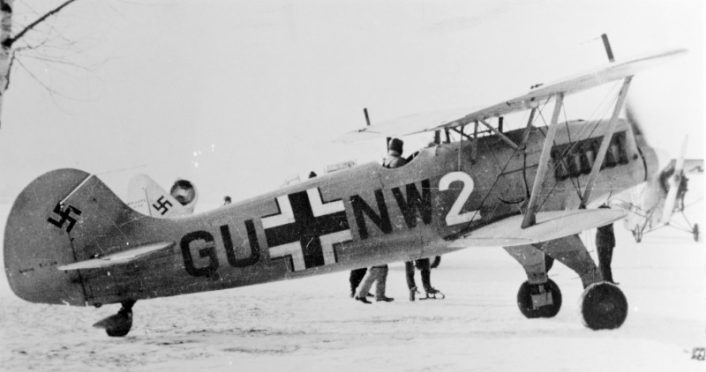
Baptism of Fire
In late July, 1936, Adolf Hitler sent twenty Junkers Ju 52/3m three-engine transports to the aid of Spanish Nationalist, General Francisco Franco. The aircraft were used to ferry Moorish troops from Morocco to Spain, since most of the Spanish Navy had sided with the Republicans in the Spanish Civil War. Fascist Italy also supplied eleven Savoia-Marchetti S.M. 81 three-engine transports to the cause. Thousands of troops were transported across the Mediterranean from Spanish Morocco to Nationalist held territories in Spain by these aircraft.
Germany established the “Tourist Company”, an organization to transport German volunteers to Spain to assist Franco’s cause. Six Heinkel He 51 fighters and pilots along with support personnel shipped to Spain on the Usaramo passenger ship on Aug. 1, 1936. The pilots and fellow servicemen were officially discharged from the German military, required to turn in their uniforms, and sworn to utmost secrecy. The mission of the fighter pilots flying the He 51’s was to protect the Ju 52’s flying transport missions and to avoid combat if possible.
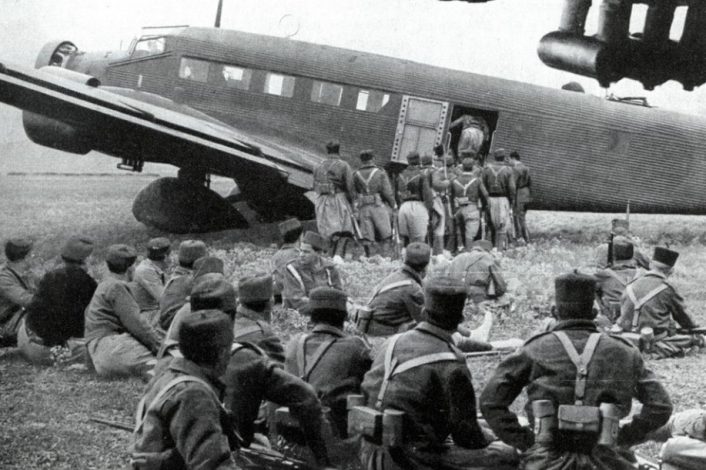
One German pilot of notable mention, Hannes Trautloft, claimed a total of five Republican aircraft downed during his time in Spain. He described having to wear shorts and a T-shirt since they had no uniforms, and the heat made the sports clothing more comfortable. However, he was himself shot down flying a He 51, and when he bailed out over friendly territory, the Spanish Nationalists were a bit puzzled of what to make of a tennis player falling from the sky, and the language barrier didn’t help. Trautloft was eventually able to calm his captors upon showing his passport, and was released. Trautloft was the first German fighter pilot to be shot down in Spain.
The first batch of He 51s was handed to Spanish pilots, and some crashed or were damaged on landing, and this, combined with an influx of Soviet aircraft, particularly fighters flown by Soviet pilots, on the Spanish Republican side, gave Germany pause to continuing operating under utmost secrecy, and on Nov. 7, 1936, Germany openly established the Legion Condor (Condor Legion) contingent of the German Luftwaffe supporting the Spanish Nationalist forces. Wolfram von Richthofen became the Chief of Staff of the Luftwaffe commander in charge, Hugo Sperrle.
Wolfram von Richthofen was the cousin of World War One famed Manfred von Richthofen, the “Red Baron”. In fact, Manfred died chasing down a fighter that had attacked Wolfram and his aircraft during aerial combat in World War One. During the Spanish Civil War, Wolfram began to formulate the use of close air support in military operations, including improving communications between aircraft and ground forces. Many of the tactics developed by Richthofen and the Condor Legion would become part of Luftwaffe doctrine and used in World War Two.
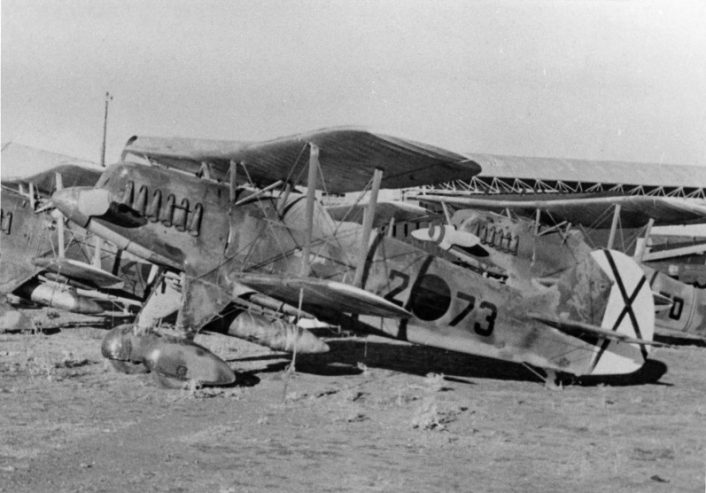
Soon after the arrival of the Soviet aircraft, it became clear the He 51 was outclassed and outgunned. Once thought of as superior if not at least on-par with the world’s air forces, the He 51s began to encounter the Polikarpov IL-15 biplane fighter. The Polikarpov was faster at 224 mph, more maneuverable, had an armored seat, and carried four 7.62 mm machineguns as opposed to the two 7.92 mm guns carried by the He 51. Soon the He 51 was being replaced in Spain by prototypes of the Messerschmitt Bf-109 and the new Heinkel He 112.
The He 51’s were relegated to mainly close support and ground attack roles into 1937. Racks for six 22 lb. bombs could be fastened under the wings. The aircraft achieved some success in this role, and that led to the He 51C-1 model, which was fitted at the onset with bomb racks under the wings. Later versions were equipped with improved radio equipment and designated the He 51C-2.
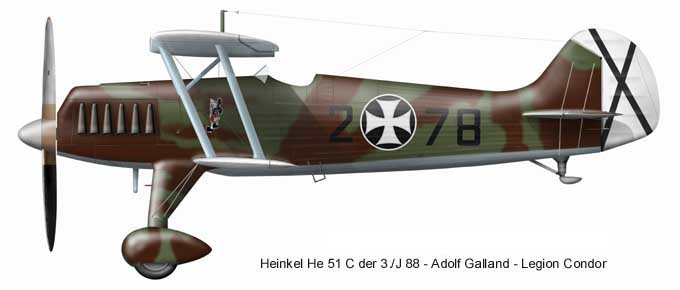
New Duty
In the fall of 1938, most of the He 51s had been replaced by the Messerschmitt Bf-109 models. He 51s would now serve primarily as a trainer for the Luftwaffe throughout most of World War Two, although some were still used in front -line close support roles in 1938. A total of seven hundred were built, serving not only the Luftwaffe and the Spanish Nationalist forces, as Bulgaria acquired twelve He 51s.
Heinkel had envisioned and developed high altitude versions of the aircraft by lengthening the wings on a standard He 51B, as well designing a high altitude interceptor version that would be designated the He 52E, but the design was already obsolete and these models never made it into production.
The Heinkel He 51 together with the Arado Ar-65 was the Luftwaffe’s first production fighters. Many German pilots flying He 51s over Spain would learn to perfect their deadly craft in preparation for a much larger and bloodier conflict on the near horizon, World War Two.
